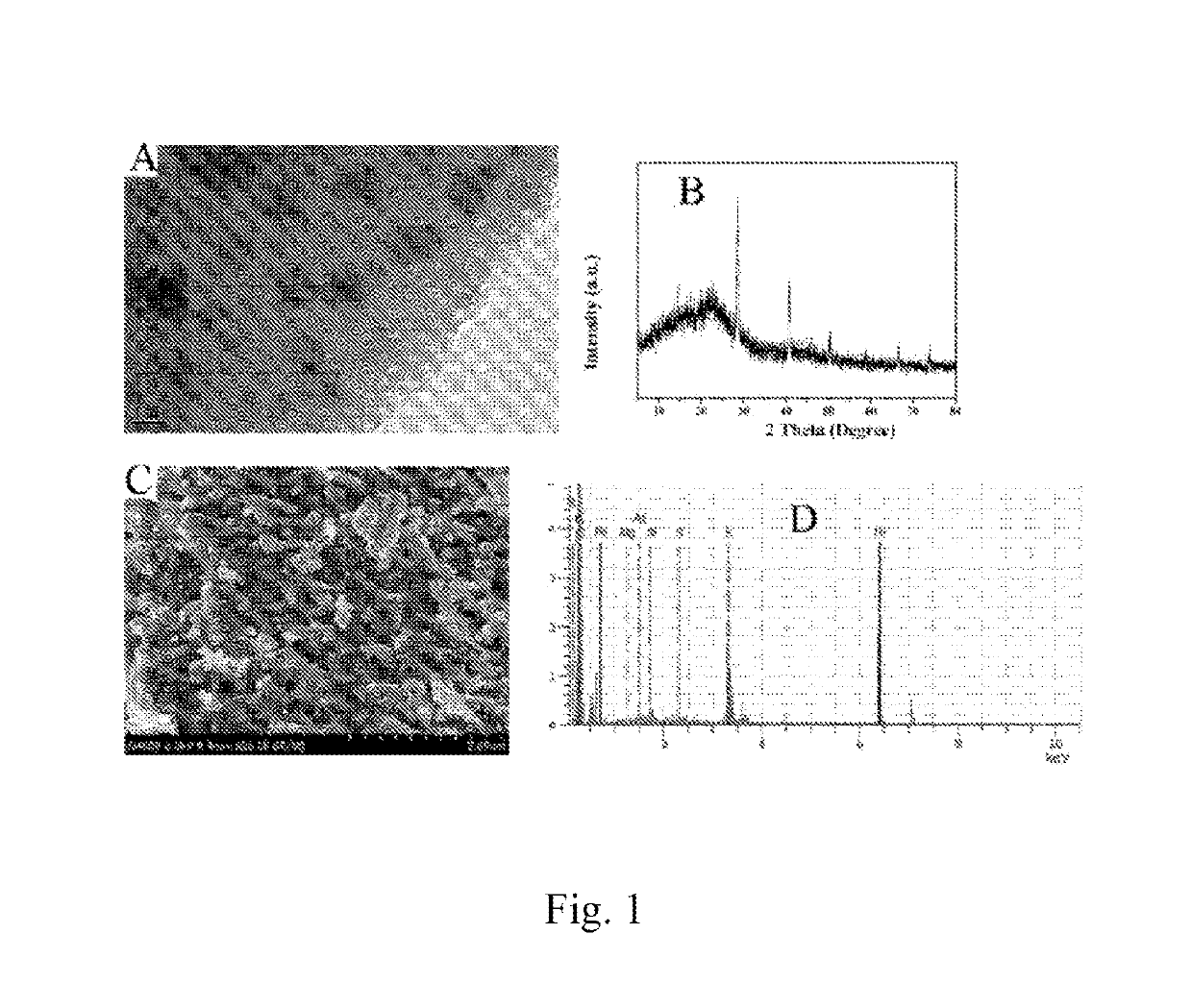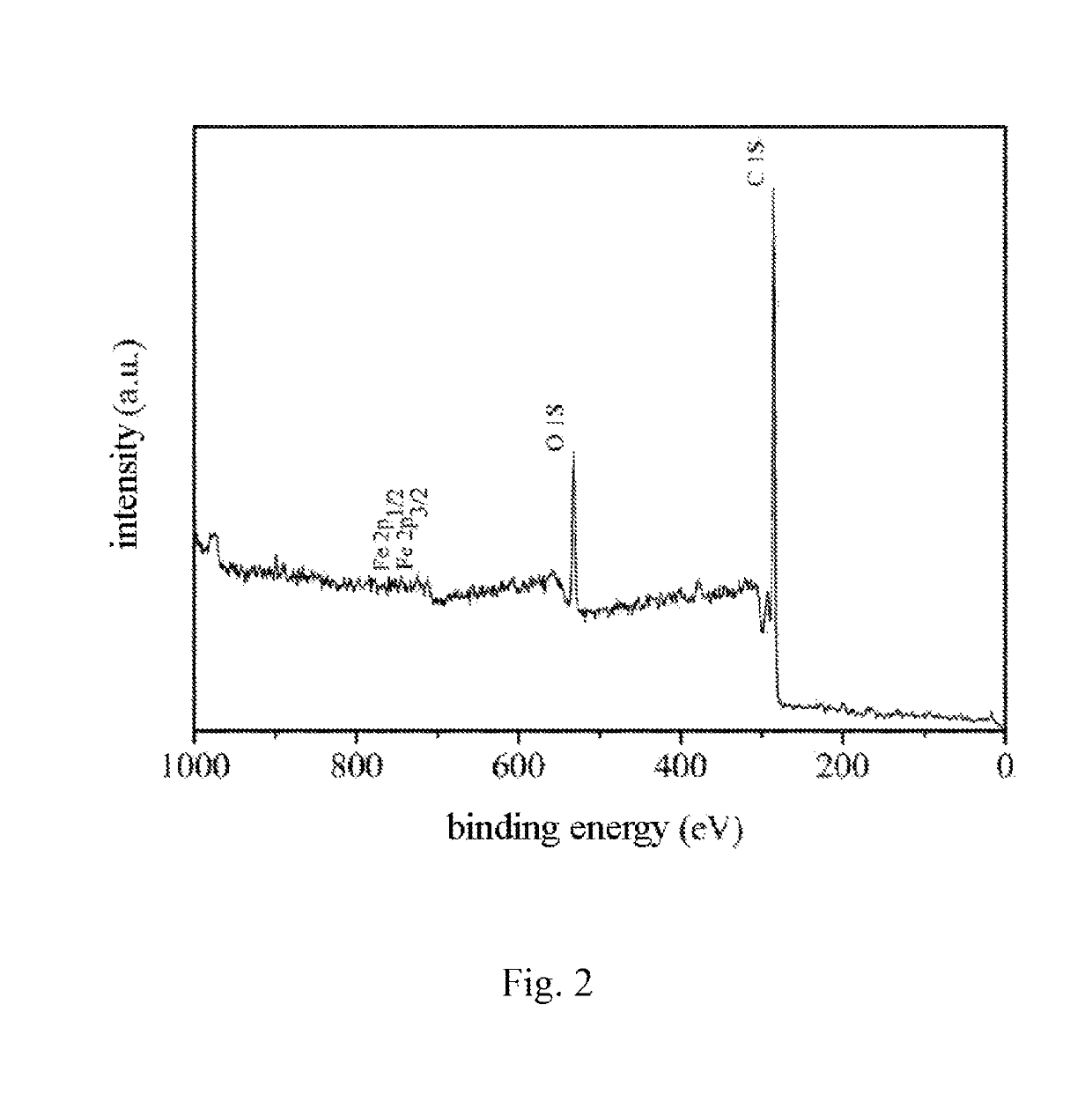Iron-based biochar material, preparation therefor and use thereof in soil pollution control
a biochar and iron-based technology, applied in the field of soil heavy metal remediation, can solve the problems of reducing soil quality, arsenic and cadmium in the soil have strong biological migration and toxicity, and the soil suffers severe arsenic-cadmium combined pollution, etc., to achieve stable properties, reduce the effect of cadmium-arsenic combined pollution in the soil and maintain long-term effectiveness
- Summary
- Abstract
- Description
- Claims
- Application Information
AI Technical Summary
Benefits of technology
Problems solved by technology
Method used
Image
Examples
example 1 preparation
of an Iron-Based Biochar Material Sample 1
[0039]1. Preparation of the Biochar Material
[0040]Palm is dried in the air; 10 kg is weighed, placed in a high-temperature furnace, and slowly heated to 200° C.; the temperature is maintained for 2 hours, and then increased at a rate of 5° C. / min; the material is further heated to 800° C. and maintained at that temperature for 3 hours; the heating is stopped and the biochar material is prepared.
[0041]2. Preparation of a Mixture of Iron and Biochar
[0042]2500 g of a ferrous sulfate solid is weighed and added to the biochar material prepared in Example 1 under agitation to obtain a mixture of iron and biochar in which the mass ratio of carbon to iron is 9:1 and the reaction is stirred for 1 hour.
[0043]3. Activation of the Biochar Material
[0044]500 g of sodium borohydride is weighed and dissolved in 500 mL of purified water to prepare as a sodium borohydride reducing agent solution having a mass fraction of 1%.
[0045]The sodium borohydride reduct...
example 2 preparation
of an Iron-Based Biochar Material Sample 2
[0050]1. Preparation of the Biochar Material
[0051]Palm is dried in the air; 10 kg is weighed, placed in a high-temperature furnace, and slowly heated to 200° C.; the temperature is maintained for 2 hours, and then increased at a rate of 5° C. / min; the material is further heated to 300° C. and maintained at that temperature for 12 hours; the heating is stopped and the biochar material is prepared.
[0052]2. Preparation of a Mixture of Iron and Biochar
[0053]1250 g of a ferric nitrate solid is weighed and added to the biochar material prepared in step 1 under agitation to obtain a mixture of iron and biochar in which the mass ratio of carbon to iron is 9:1 and the reaction is stirred for 1 hour.
[0054]3. Activation of the Biochar Material
[0055]50 g of sodium borohydride is weighed and dissolved in 250 mL of purified water to prepare as a sodium borohydride reducing agent solution having a mass fraction of 0.2%.
[0056]The sodium borohydride reductan...
example 3 preparation
of an Iron-Based Biochar Material Sample 3
[0061]1. Preparation of the Biochar Material
[0062]Chaff is dried in the air; 10 kg is weighed, placed in a high-temperature furnace, and slowly heated to 200° C.; the temperature is maintained for 2 hours, and then increased at a rate of 5° C. / min; the material is further heated to 500° C. and maintained at that temperature for 9 hours; the heating is stopped and the biochar material is prepared. 2. Preparation of a Mixture of Iron and Biochar
[0063]250 g of a ferric sulfate solid is weighed and added to the biochar material prepared in step 1 under agitation to obtain a mixture of iron and biochar in which the mass ratio of carbon to iron is 50:1 and the reaction is stirred for 1 hour.
[0064]3. Activation of the Biochar Material
[0065]5 g of sodium borohydride is weighed and dissolved in 500 mL of purified water to prepare as a sodium borohydride reducing agent solution having a mass fraction of 0.01%.
[0066]The sodium borohydride reductant sol...
PUM
| Property | Measurement | Unit |
|---|---|---|
| temperature | aaaaa | aaaaa |
| temperature | aaaaa | aaaaa |
| temperature | aaaaa | aaaaa |
Abstract
Description
Claims
Application Information
 Login to View More
Login to View More - R&D
- Intellectual Property
- Life Sciences
- Materials
- Tech Scout
- Unparalleled Data Quality
- Higher Quality Content
- 60% Fewer Hallucinations
Browse by: Latest US Patents, China's latest patents, Technical Efficacy Thesaurus, Application Domain, Technology Topic, Popular Technical Reports.
© 2025 PatSnap. All rights reserved.Legal|Privacy policy|Modern Slavery Act Transparency Statement|Sitemap|About US| Contact US: help@patsnap.com



